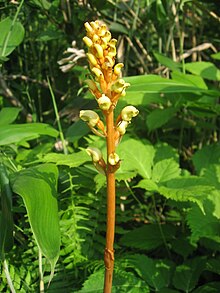| Gastrodia elata | |
|---|---|

| |
| Fukushima pref., Japan | |
| Conservation status | |
 Vulnerable (IUCN 3.1) | |
| CITES Appendix II (CITES) | |
| Scientific classification | |
| Kingdom: | Plantae |
| Clade: | Tracheophytes |
| Clade: | Angiosperms |
| Clade: | Monocots |
| Order: | Asparagales |
| Family: | Orchidaceae |
| Subfamily: | Epidendroideae |
| Tribe: | Gastrodieae |
| Genus: | Gastrodia |
| Species: | G. elata |
| Binomial name | |
| Gastrodia elata Blume | |
| Subspecies | |
| |
| Synonyms | |
| |
Gastrodia elata is a saprophytic perennial herb in the family Orchidaceae. It is found in Nepal, Bhutan, India, Japan, Korea, Siberia, Taiwan, and China.
Description
The orchid has an 8–12 centimeters long elliptical underground rhizome with a diameter of 3–5 centimeters but may grow up to 7 centimeters. The stem is erect with a height of 0.3–1 meter up to 2 meters, the orange yellow, tan, cylinder, and leafless.
The flowered pale olivine or the orange red, the scape is length 5–30 centimeters, longest may be 50 centimeters. Floral Bractsare long lanceolate, length 1-1.5 centimeters; Pedicel and ovary of branch 0.7–1.2 centimeter, slightly short in colored bract; The sepal and the petal produce a slanting pot shape perianth tube, the perianth tube long the approximately 1 centimeter, the diameter 5–7 millimeters. The labellum is white, circular, with a length of 6–7 millimeters and width of 3–4 millimeters, the tip 3 cracks, the base pastes the tight pistil column full terminal, has a pair of pulp callus, in the callus connection perianth tube. The pistil column length 5–7 millimeters, have the short pistil column foot.
Capsule each approximately 30, oval or but actually oval, length 1.2–1.8 centimeters, width 8–9 millimeters. The seed are most, 2 – 40,000 grains of each fruit, minimum, powdery. Flowering season June to July, fruit time July to August.
Growth
Gastrodia elata grows in symbiosis with the fungus Armillaria mellea on rotting wood, depending on the hypha of the fungus to invade the root system so that the plant can absorb nutrients from A. mellea.
Distribution and habitat
It is found in Nepal, Bhutan, India, Japan (Hokkaido, Honshu, Shikoku, Kyuushu), Korea, Siberia, Taiwan, and China (in the provinces of Jilin, Liaoning, Inner Mongolia, Hebei, Shanxi, Shanxi, Gansu, Jiangsu, Anhui, Zhejiang, Jiangxi, Henan, Hunan, Hubei, Sichuan, Guizhou, Yunnan, and Tibet). It grows at elevations of 400–3,200 m (1,300–10,500 ft), at the edge of forests.
Chemical properties
4-Hydroxybenzaldehyde and gastrodin can be found in the orchid G. elata. It also produces 2,4-Bis(4-hydroxybenzyl) phenol, gastrol, gastrodigenin and other related compounds.
Traditional use
The herb is used in traditional Chinese medicine and Sichuan cuisine. It is one of the three orchids listed in the earliest known Chinese Materia Medica (Shennon bencaojing) (c. 100 AD). Medicinally, it is used for 'calming the liver' and for treating headaches, dizziness, tetanus, and epilepsy. According to "Nutrition Review," "Gastrodia root has been shown to exert novel pain relief and inflammatory-mediating activities, as well as in vivo and in vitro inhibitory activity on nitric oxide (NO) production."
Notes
- Subject to CITES Annotation #4
References
- China Plant Specialist Group (2004). "Gastrodia elata". IUCN Red List of Threatened Species. 2004: e.T46671A11069069. doi:10.2305/IUCN.UK.2004.RLTS.T46671A11069069.en. Retrieved 6 October 2021.
- "Appendices | CITES". cites.org. Retrieved 14 January 2022.
- ^ 芦笛 (2009). 天麻、赤箭、徐长卿、鬼督邮名实考. 中医文献杂志 (in Chinese). 27 (4). ISSN 1006-4737. Archived from the original on 2011-07-24. Retrieved 2010-01-25.
- 陈心启、吉占和、郎楷永 等, ed. (October 1999). 中国植物志 第18卷 (PDF) (in Chinese). 北京: 科学出版社. pp. 31-33. ISBN 978-7-03-007322-8. Retrieved 2010-01-24.
- 昆明植物研究所. 天麻. 《中国高等植物数据库全库》 (in Chinese). 中国科学院微生物研究所. Archived from the original on 2013-10-05. Retrieved 2010-01-25.
- 4-Hydroxybenzaldehyde from Gastrodia elata B1. is active in the antioxidation and GABAergic neuromodulation of the rat brain. Jeoung-Hee Ha, Dong-Ung Lee, Jae-Tae Lee, Jin-Sook Kim, Chul-Soon Yong, Jung-Ae Kim, Jung-Sang Ha and Keun- Huh, Journal of Ethnopharmacology, Volume 73, Issues 1–2, November 2000, Pages 329–333, doi:10.1016/S0378-8741(00)00313-5
- 2,4-Bis(4-hydroxybenzyl) phenol from Gastrodia elata. Naoki Noda, Yukio Kobayashi, Kazumoto Miyahara and Saeko Fukahori, doi:10.1016/0031-9422(95)00051-8
- Phenolic compounds from Gastrodia rhizome and relaxant effects of related compounds on isolated smooth muscle preparation. Junko Hayashi, Toshikazu Sekine, Shigeyoshi Deguchi, Qing Lin, Syunji Horie, Shizuko Tsuchiya, Shingo Yano, Kazuo Watanabe and Fumio Ikegami, Phytochemistry, Volume 59, Issue 5, March 2002, Pages 513–519, doi:10.1016/S0031-9422(02)00008-0
- Chung-Fen Tsaia, 1, Chuen-Lin Huangb, c, 1, Yun-Lian Lind, Yi-Chao Leee, Ying-Chen Yangf, Nai-Kuei Huangd, g, "The neuroprotective effects of an extract of Gastrodia elata",Journal of Ethnopharmacology Volume 138, Issue 1, 31 October 2011, Pages 119–125
- Jim English (2013). "Traditional Chinese Herbs for Arthritis". Nutrition Review. 5 (2). Retrieved 2022-07-17.
- IUCN Red List vulnerable species
- Gastrodia
- Orchids of China
- Orchids of India
- Orchids of Japan
- Orchids of Russia
- Orchids of Taiwan
- Orchids of Nepal
- Flora of Bhutan
- Flora of South Korea
- Flora of North Korea
- Flora of Siberia
- Vulnerable plants
- Orchids of Guizhou
- Orchids of Sichuan
- Orchids of Yunnan
- Flora of Anhui
- Flora of Gansu
- Flora of Hebei
- Flora of Henan
- Flora of Hubei
- Flora of Hunan
- Flora of Inner Mongolia
- Flora of Jiangsu
- Flora of Jiangxi
- Flora of Shanxi
- Flora of Tibet
- Flora of Zhejiang
- Taxa named by Carl Ludwig Blume